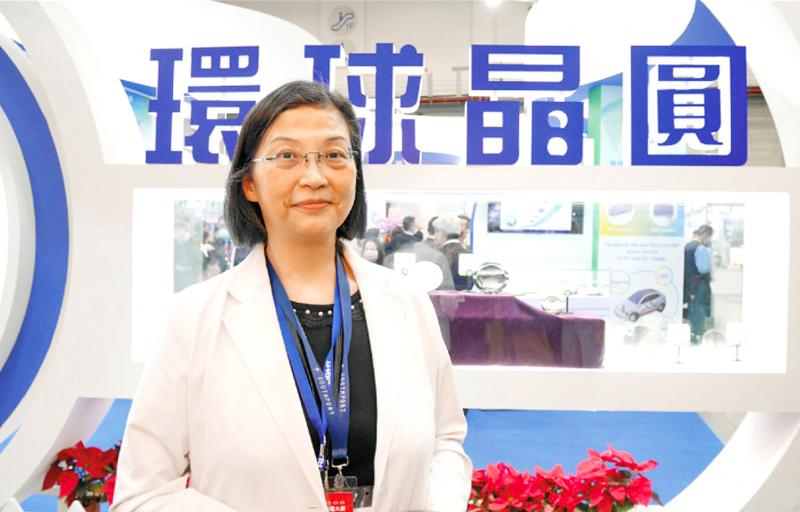GlobalWafers Inc (環球晶圓), the world’s No. 3 silicon wafer supplier, yesterday reiterated its positive outlook on business until 2025, as customers continue to show a strong interest in securing wafer supply by signing long-term supply agreements (LTAs).
The Hsinchu-based company saw prepayments from LTAs swell to a record NT$33.11 billion (US$1.12 billion), up 15 percent from the end of last year, undeterred by growing uncertainty about macro environmental risks including impact from COVID-19 lockdowns, the Russia-Ukraine war, rising interest rates, and higher energy and freight costs.
“We continue to sign LTA contracts, especially for larger diameter wafers and advanced products, with 300-millimeter wafers being our customers’ primary target,” GlobalWafers chairperson Doris Hsu (徐秀蘭) told investors at a teleconference.

Photo: Fang Wei-jie, Taipei Times
“We have yet to see a cooling-off in demand from our customers,” Hsu said.
“There is some unevenness in the end market, with demand from the smartphone and notebook markets, for example, slowing slightly, while demand from the automotive, industrial and server markets continue to be very hot,” she added.
“So far, there has been no order cancelation or pushout from our customers,” she added.
Demand is strongest for all types of 300-millimeter wafers, followed by wafers made of compound semiconductor materials, mainly silicon carbide and gallium nitride, GlobalWafers said.
To satisfy the robust demand, the company said it was maintaining its NT$100 billion capacity expansion plan, which includes brownfield and greenfield projects at six sites in Taiwan, the US, Italy, South Korea, Japan and Denmark.
Much longer lead times in equipment delivery could create a bottleneck, and that could lead to a delay of one to two quarters in the construction of new production lines, Hsu said.
All production lines are running at full capacity, she said.
In the first quarter, GlobalWafers’ net profit plunged 35 percent year-on-year to NT$1.75 billion, dragged by a loss of more than NT$6 billion from a drop in 13.67 percent-held Siltronic AG’s market value and foreign exchange rate fluctuations.
That translated into earnings per share of NT$4.01, down from NT$6.18 a year earlier.
Excluding the unrealized losses from Siltronic, GlobalWafers would have seen a record profit of NT$14.16 per share last quarter, the company said.
Operating profit surged 49 percent to NT$5.89 billion, and gross margin improved to a record 42.6 percent, from 35.1 percent a year ago.
GlobalWafers said it is hard to predict whether its gross margin would be able to rise to the levels — 46 or 48 percent — posted by foundry companies or integrated device manufacturers, given the uncertainty arising from the impending imposition of a carbon emissions tax and higher energy costs.
Wafer manufacturing is a power-intensive industry, the company said.

Shiina Ito has had fewer Chinese customers at her Tokyo jewelry shop since Beijing issued a travel warning in the wake of a diplomatic spat, but she said she was not concerned. A souring of Tokyo-Beijing relations this month, following remarks by Japanese Prime Minister Sanae Takaichi about Taiwan, has fueled concerns about the impact on the ritzy boutiques, noodle joints and hotels where holidaymakers spend their cash. However, businesses in Tokyo largely shrugged off any anxiety. “Since there are fewer Chinese customers, it’s become a bit easier for Japanese shoppers to visit, so our sales haven’t really dropped,” Ito

The number of Taiwanese working in the US rose to a record high of 137,000 last year, driven largely by Taiwan Semiconductor Manufacturing Co’s (TSMC, 台積電) rapid overseas expansion, according to government data released yesterday. A total of 666,000 Taiwanese nationals were employed abroad last year, an increase of 45,000 from 2023 and the highest level since the COVID-19 pandemic, data from the Directorate-General of Budget, Accounting and Statistics (DGBAS) showed. Overseas employment had steadily increased between 2009 and 2019, peaking at 739,000, before plunging to 319,000 in 2021 amid US-China trade tensions, global supply chain shifts, reshoring by Taiwanese companies and

Taiwan Semiconductor Manufacturing Co (TSMC, 台積電) received about NT$147 billion (US$4.71 billion) in subsidies from the US, Japanese, German and Chinese governments over the past two years for its global expansion. Financial data compiled by the world’s largest contract chipmaker showed the company secured NT$4.77 billion in subsidies from the governments in the third quarter, bringing the total for the first three quarters of the year to about NT$71.9 billion. Along with the NT$75.16 billion in financial aid TSMC received last year, the chipmaker obtained NT$147 billion in subsidies in almost two years, the data showed. The subsidies received by its subsidiaries —

Taiwan Semiconductor Manufacturing Co (TSMC) Chairman C.C. Wei (魏哲家) and the company’s former chairman, Mark Liu (劉德音), both received the Robert N. Noyce Award -- the semiconductor industry’s highest honor -- in San Jose, California, on Thursday (local time). Speaking at the award event, Liu, who retired last year, expressed gratitude to his wife, his dissertation advisor at the University of California, Berkeley, his supervisors at AT&T Bell Laboratories -- where he worked on optical fiber communication systems before joining TSMC, TSMC partners, and industry colleagues. Liu said that working alongside TSMC